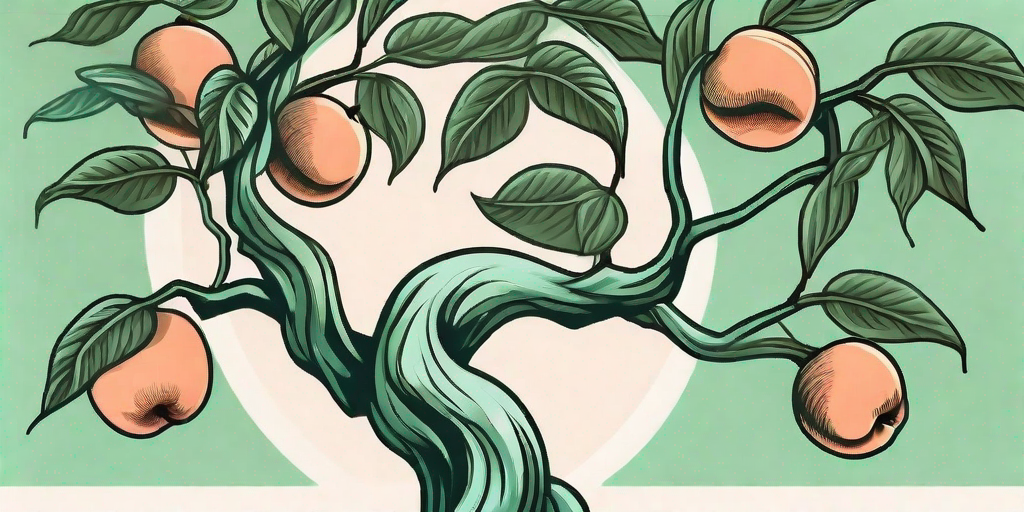
Ah, the peach tree. A symbol of longevity, immortality, and the sweet, juicy promise of a summer harvest. But what happens when your beloved tree starts to sport curling leaves instead of luscious fruits? Fear not, dear reader, for we have the answers you seek.
Understanding Peach Leaf Curl
Before we dive into the nitty-gritty of how to banish curling leaves, let's first understand what we're dealing with. Peach leaf curl is a fungal disease, and like any good villain, it has a fancy Latin name: Taphrina deformans. This fungus causes the leaves of your peach tree to curl and become discolored, which is as unattractive as it sounds.
But it's not just about aesthetics. This disease can severely affect the health and productivity of your tree. So, if you've been dreaming of peach pies, jams, and smoothies, it's time to roll up your sleeves and get to work.
Identifying Peach Leaf Curl
Signs and Symptoms
Like a bad houseguest, peach leaf curl makes its presence known in a variety of annoying ways. The first signs usually appear in spring when the leaves start to grow. They may become red, blistered, and, you guessed it, curled. As the disease progresses, the leaves may turn gray or white and fall off the tree. If left untreated, it can lead to a reduced harvest or even tree death. And nobody wants that.
But wait, there's more! The fungus can also affect the fruit, causing red spots, blisters, and a general decline in peachy goodness. So, if your peaches are looking more like a teenager's acne-ridden face than a picture-perfect fruit, you might have a problem.
Causes
Peach leaf curl is caused by the fungus Taphrina deformans, which overwinters in the bark and buds of the tree. In spring, when conditions are wet and cool, the fungus springs into action, infecting the new leaves as they emerge. The disease is most severe in years when spring is cool and wet.
Unfortunately, the fungus is quite resilient and can survive in fallen leaves and debris, making it a recurring nightmare for many gardeners. But don't despair, we have some tricks up our sleeve to help you tackle this problem head-on.
Preventing Peach Leaf Curl
Choose Resistant Varieties
As the old saying goes, prevention is better than cure. And in the case of peach leaf curl, this is certainly true. One of the best ways to prevent this disease is to choose resistant varieties of peach trees. These include 'Frost', 'Indian Free', 'Q-1-8', and 'Muirs'. So, if you're planning to plant a new peach tree, make sure to do your homework first.
However, keep in mind that even resistant varieties can get the disease if conditions are favorable for the fungus. So, don't rest on your laurels just yet.
Proper Pruning
Pruning your peach tree can help prevent peach leaf curl by improving air circulation and reducing the number of places where the fungus can hide. It's like giving your tree a good haircut – it not only looks better but also feels better.
Prune your tree in late winter or early spring before the buds start to swell. Remove dead or diseased wood, inward-growing branches, and any branches that are crossing or rubbing against each other. Remember, your goal is to create an open, vase-like shape that allows light and air to reach all parts of the tree.
Treating Peach Leaf Curl
Fungicide Application
If your tree is already showing signs of peach leaf curl, it's time to bring out the big guns: fungicides. These can be applied in late winter or early spring before the buds start to swell. Some effective options include copper-based fungicides and synthetic fungicides like chlorothalonil.
Remember to follow the manufacturer's instructions for application rates and safety precautions. After all, while we want to kill the fungus, we don't want to harm ourselves or the environment in the process.
Sanitation
Another important step in treating peach leaf curl is sanitation. This involves removing and destroying any fallen leaves and debris from around the tree. Remember, these can harbor the fungus and cause reinfection. So, grab your rake and get to work!
FAQs
- Can peach leaf curl spread to other trees?
Yes, peach leaf curl can spread to other susceptible trees, including nectarines. However, it does not affect other types of fruit trees.
- Can I eat peaches from a tree with peach leaf curl?
Yes, the fruit from a tree with peach leaf curl is safe to eat. However, the disease can affect the quantity and quality of the fruit.
- Can peach leaf curl be cured?
Once a leaf is infected, it cannot be cured. However, the disease can be managed with proper care and treatment, and healthy new leaves can grow in place of the infected ones.
So there you have it, folks. With a bit of knowledge, some preventative measures, and a dash of elbow grease, you can say goodbye to curling peach tree leaves and hello to a healthy, productive harvest. Now, who's ready for some peach pie?











